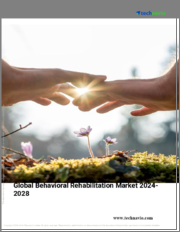
|
시장보고서
상품코드
1701954
행동 재활 시장 보고서 : 행동 장애 유형별, 헬스케어 환경별, 치료 방법별, 지역별(2025-2033년)Behavioral Rehabilitation Market Report by Type of Behavioral Disorder, Healthcare Setting, Treatment Method, and Region 2025-2033 |
||||||
세계의 행동 재활 시장 규모는 2024년에 2,650억 달러에 달했습니다. 향후 IMARC Group은 시장이 2033년까지 3,730억 달러에 달하며, 2025-2033년에 3.9%의 성장률(CAGR)을 보일 것으로 예측하고 있습니다. 정신건강에 대한 의식의 향상, 행동 장애의 이환율 증가, 정부의 헬스케어 정책의 지원, 지속적 기술의 진보가 시장 성장 원동력이 되고 있습니다.
행동재활은 개인의 행복에 해로운 특정 학습 행동을 치료하는 데 사용되는 심리치료 기술을 말합니다. 상담, 약수처리, 강화, 처벌, 모델링 등 다양한 지원 서비스를 실시하여 개인의 심리적 조건을 변화시키고, 자기 파괴적이고 건강에 해로운 행동의 발생을 최소화합니다. 과민성, 부적절한 행동, 약물 남용, 우울증, 불안, 충동성, 공격성, 과잉행동, 슬픔과 관련된 패턴을 식별하고 해결하도록 돕습니다. 행동재활은 개인의 감정과 행동을 효과적으로 관리하고, 성격장애, 기분장애, 주의력결핍장애를 치료할 수 있도록 합니다.
행동재활 시장 동향 :
불안장애, 치매, 우울증 및 기타 정신장애의 유병률 증가는 시장 성장을 가속하는 주요 요인 중 하나입니다. 또한 환자들 사이에서 부분 입원 프로그램(PHP)에 대한 선호도가 높아지고 있는 것도 시장 성장을 가속하고 있습니다. 이러한 여러 날에 걸친 프로그램은 재활센터와 병원에서 운영되며 감정 조절, 갈등 해결, 분노 관리, 약물 남용 치료를 촉진합니다. 이에 따라 다양한 정부 기관 및 비정부 조직도 외상 후 스트레스 장애(PTSD)와 약물 중독으로 고통받는 사람들에게 행동 재활을 제공하기 위한 캠프를 개최하고 있으며, 이는 시장 성장에 기여하고 있습니다. 또한 온라인 상담 서비스의 가용성이 또 다른 성장 촉진요인으로 작용하고 있습니다. 코로나바이러스(COVID-19)의 대유행으로 인해 적시에 치료 및 회복 지원을 받기 위해 온라인 플랫폼이 널리 채택되고 있습니다. 기타 요인으로는 행동 재활에 대한 대중의 수용성이 높아지고 있으며, 정신건강에 대한 인식을 제고하기 위해 정부가 우호적인 정책을 시행하고 있는 것도 시장 성장을 가속할 것으로 예상됩니다.
이 보고서에서 다룬 주요 질문
- 2024년 세계 행동재활 시장 규모는?
- 세계 행동재활 시장의 2025-2033년 예상 성장률은?
- 세계 행동재활 시장을 촉진하는 주요 요인은 무엇인가?
- COVID-19가 세계 행동재활 시장에 미치는 영향은?
- 세계 행동재활 시장의 행동장애 유형에 따른 분류는?
- 세계 행동재활 시장의 의료환경에 따른 분류는?
- 세계 행동재활치료 시장의 치료방법별 분류는?
- 세계 행동재활 시장의 주요 지역은?
- 세계 행동재활 시장의 주요 기업은?
목차
제1장 서문
제2장 조사 범위와 조사 방법
- 조사의 목적
- 이해관계자
- 데이터 소스
- 1차 정보
- 2차 정보
- 시장 추정
- 보텀업 어프로치
- 톱다운 어프로치
- 조사 방법
제3장 개요
제4장 서론
- 개요
- 주요 업계 동향
제5장 세계의 행동 재활 시장
- 시장 개요
- 시장 실적
- COVID-19의 영향
- 시장 예측
제6장 시장 내역 : 행동 장애 유형별
- 불안장애
- 기분 장애
- 약물 남용 장애
- 인격장애
- 주의력결핍장애
제7장 시장 내역 : 헬스케어 환경별
- 외래
- 입원
- 시설
제8장 시장 내역 : 치료 방법별
- 카운셀링
- 약제
- 지원 서비스
- 기타
제9장 시장 내역 : 지역별
- 북미
- 미국
- 캐나다
- 아시아태평양
- 중국
- 일본
- 인도
- 한국
- 호주
- 인도네시아
- 기타
- 유럽
- 독일
- 프랑스
- 영국
- 이탈리아
- 스페인
- 러시아
- 기타
- 라틴아메리카
- 브라질
- 멕시코
- 기타
- 중동 및 아프리카
- 시장 내역 : 국가별
제10장 SWOT 분석
- 개요
- 강점
- 약점
- 기회
- 위협
제11장 밸류체인 분석
제12장 Porter's Five Forces 분석
- 개요
- 바이어의 교섭력
- 공급 기업의 교섭력
- 경쟁의 정도
- 신규 진출업체의 위협
- 대체품의 위협
제13장 가격 분석
제14장 경쟁 구도
- 시장 구조
- 주요 기업
- 주요 기업의 개요
- Acadia Healthcare
- American Addiction Centers
- Aurora Behavioral Health System
- Behavioral Health Group
- Haven Behavioral Healthcare Inc.
- Magellan Health Inc.
- Niznik Behavioral Health
- Promises Behavioral Health
- Springstone Inc.
- Universal Health Services Inc.
The global behavioral rehabilitation market size reached USD 265 Billion in 2024. Looking forward, IMARC Group expects the market to reach USD 373 Billion by 2033, exhibiting a growth rate (CAGR) of 3.9% during 2025-2033. The rising mental health awareness, increasing incidence of behavioral disorders, supporting government healthcare policies, and ongoing technological advancements are driving the market growth.
Behavioral rehabilitation refers to a psychotherapeutic technique used for the treatment of specific learned behaviors that are detrimental to the wellbeing of an individual. It involves the administration of counseling, medication and various support services, such as reinforcement, punishment and modeling, to alter the psychological conditioning of the individual and minimize the occurrence of self-destructive and unhealthy behaviors. It aids in the identification and resolution of patterns related to irritability, inappropriate actions, substance abuse, depression, anxiety, impulsivity, aggression, hyperactivity and grief. Behavioral rehabilitation enables the individual to effectively manage their emotions and actions and treat personality, mood and attention deficit disorders.
Behavioral Rehabilitation Market Trends:
The increasing prevalence of anxiety, dementia, depression and other psychological disorders among the masses is one of the key factors driving the market growth. Moreover, the rising preference for partial hospitalization programs (PHPs) among the patients is providing a thrust to the market growth. These multi-day programs are run by rehabilitation centers and hospitals to facilitate emotional regulation, conflict resolution, anger management and treat substance abuse. In line with this, various government and non-government organizations also organize camps to provide behavioral rehabilitation to individuals suffering from post-traumatic stress disorder (PTSD) and drug addiction, which is contributing to the growth of the market. Additionally, the availability of online counseling services is acting as another growth-inducing factor. Due to the onset of the coronavirus (Covid-19) pandemic, individuals are widely adopting online platforms for obtaining timely treatment and recovery support. Other factors, including the increasing acceptance for behavioral rehabilitation among the masses, along with the implementation of favorable government policies to create awareness regarding mental health, are anticipated to drive the market growth.
Key Market Segmentation:
Breakup by Type of Behavioral Disorder:
- Anxiety Disorder
- Mood Disorder
- Substance Abuse Disorder
- Personality Disorder
- Attention Deficit Disorder
Breakup by Healthcare Setting:
- Outpatient
- Inpatient
- Residential
Breakup by Treatment Method:
- Counselling
- Medication
- Support Services
- Others
Breakup by Region:
- North America
- United States
- Canada
- Asia-Pacific
- China
- Japan
- India
- South Korea
- Australia
- Indonesia
- Others
- Europe
- Germany
- France
- United Kingdom
- Italy
- Spain
- Russia
- Others
- Latin America
- Brazil
- Mexico
- Others
- Middle East and Africa
Competitive Landscape:
The competitive landscape of the industry has also been examined along with the profiles of the key players being Acadia Healthcare, American Addiction Centers, Aurora Behavioral Health System, Behavioral Health Group, Haven Behavioral Healthcare Inc., Magellan Health Inc., Niznik Behavioral Health, Promises Behavioral Health, Springstone Inc. and Universal Health Services Inc.
Key Questions Answered in This Report
- 1.What was the size of the global behavioral rehabilitation market in 2024?
- 2.What is the expected growth rate of the global behavioral rehabilitation market during 2025-2033?
- 3.What are the key factors driving the global behavioral rehabilitation market?
- 4.What has been the impact of COVID-19 on the global behavioral rehabilitation market?
- 5.What is the breakup of the global behavioral rehabilitation market based on the type of behavioral disorder?
- 6.What is the breakup of the global behavioral rehabilitation market based on the healthcare setting?
- 7.What is the breakup of the global behavioral rehabilitation market based on the treatment method?
- 8.What are the key regions in the global behavioral rehabilitation market?
- 9.Who are the key players/companies in the global behavioral rehabilitation market?
Table of Contents
1 Preface
2 Scope and Methodology
- 2.1 Objectives of the Study
- 2.2 Stakeholders
- 2.3 Data Sources
- 2.3.1 Primary Sources
- 2.3.2 Secondary Sources
- 2.4 Market Estimation
- 2.4.1 Bottom-Up Approach
- 2.4.2 Top-Down Approach
- 2.5 Forecasting Methodology
3 Executive Summary
4 Introduction
- 4.1 Overview
- 4.2 Key Industry Trends
5 Global Behavioral Rehabilitation Market
- 5.1 Market Overview
- 5.2 Market Performance
- 5.3 Impact of COVID-19
- 5.4 Market Forecast
6 Market Breakup by Type of Behavioral Disorder
- 6.1 Anxiety Disorder
- 6.1.1 Market Trends
- 6.1.2 Market Forecast
- 6.2 Mood Disorder
- 6.2.1 Market Trends
- 6.2.2 Market Forecast
- 6.3 Substance Abuse Disorder
- 6.3.1 Market Trends
- 6.3.2 Market Forecast
- 6.4 Personality Disorder
- 6.4.1 Market Trends
- 6.4.2 Market Forecast
- 6.5 Attention Deficit Disorder
- 6.5.1 Market Trends
- 6.5.2 Market Forecast
7 Market Breakup by Healthcare Setting
- 7.1 Outpatient
- 7.1.1 Market Trends
- 7.1.2 Market Forecast
- 7.2 Inpatient
- 7.2.1 Market Trends
- 7.2.2 Market Forecast
- 7.3 Residential
- 7.3.1 Market Trends
- 7.3.2 Market Forecast
8 Market Breakup by Treatment Method
- 8.1 Counselling
- 8.1.1 Market Trends
- 8.1.2 Market Forecast
- 8.2 Medication
- 8.2.1 Market Trends
- 8.2.2 Market Forecast
- 8.3 Support Services
- 8.3.1 Market Trends
- 8.3.2 Market Forecast
- 8.4 Others
- 8.4.1 Market Trends
- 8.4.2 Market Forecast
9 Market Breakup by Region
- 9.1 North America
- 9.1.1 United States
- 9.1.1.1 Market Trends
- 9.1.1.2 Market Forecast
- 9.1.2 Canada
- 9.1.2.1 Market Trends
- 9.1.2.2 Market Forecast
- 9.1.1 United States
- 9.2 Asia-Pacific
- 9.2.1 China
- 9.2.1.1 Market Trends
- 9.2.1.2 Market Forecast
- 9.2.2 Japan
- 9.2.2.1 Market Trends
- 9.2.2.2 Market Forecast
- 9.2.3 India
- 9.2.3.1 Market Trends
- 9.2.3.2 Market Forecast
- 9.2.4 South Korea
- 9.2.4.1 Market Trends
- 9.2.4.2 Market Forecast
- 9.2.5 Australia
- 9.2.5.1 Market Trends
- 9.2.5.2 Market Forecast
- 9.2.6 Indonesia
- 9.2.6.1 Market Trends
- 9.2.6.2 Market Forecast
- 9.2.7 Others
- 9.2.7.1 Market Trends
- 9.2.7.2 Market Forecast
- 9.2.1 China
- 9.3 Europe
- 9.3.1 Germany
- 9.3.1.1 Market Trends
- 9.3.1.2 Market Forecast
- 9.3.2 France
- 9.3.2.1 Market Trends
- 9.3.2.2 Market Forecast
- 9.3.3 United Kingdom
- 9.3.3.1 Market Trends
- 9.3.3.2 Market Forecast
- 9.3.4 Italy
- 9.3.4.1 Market Trends
- 9.3.4.2 Market Forecast
- 9.3.5 Spain
- 9.3.5.1 Market Trends
- 9.3.5.2 Market Forecast
- 9.3.6 Russia
- 9.3.6.1 Market Trends
- 9.3.6.2 Market Forecast
- 9.3.7 Others
- 9.3.7.1 Market Trends
- 9.3.7.2 Market Forecast
- 9.3.1 Germany
- 9.4 Latin America
- 9.4.1 Brazil
- 9.4.1.1 Market Trends
- 9.4.1.2 Market Forecast
- 9.4.2 Mexico
- 9.4.2.1 Market Trends
- 9.4.2.2 Market Forecast
- 9.4.3 Others
- 9.4.3.1 Market Trends
- 9.4.3.2 Market Forecast
- 9.4.1 Brazil
- 9.5 Middle East and Africa
- 9.5.1 Market Trends
- 9.5.2 Market Breakup by Country
- 9.5.3 Market Forecast
10 SWOT Analysis
- 10.1 Overview
- 10.2 Strengths
- 10.3 Weaknesses
- 10.4 Opportunities
- 10.5 Threats
11 Value Chain Analysis
12 Porters Five Forces Analysis
- 12.1 Overview
- 12.2 Bargaining Power of Buyers
- 12.3 Bargaining Power of Suppliers
- 12.4 Degree of Competition
- 12.5 Threat of New Entrants
- 12.6 Threat of Substitutes
13 Price Analysis
14 Competitive Landscape
- 14.1 Market Structure
- 14.2 Key Players
- 14.3 Profiles of Key Players
- 14.3.1 Acadia Healthcare
- 14.3.1.1 Company Overview
- 14.3.1.2 Product Portfolio
- 14.3.1.3 Financials
- 14.3.2 American Addiction Centers
- 14.3.2.1 Company Overview
- 14.3.2.2 Product Portfolio
- 14.3.3 Aurora Behavioral Health System
- 14.3.3.1 Company Overview
- 14.3.3.2 Product Portfolio
- 14.3.4 Behavioral Health Group
- 14.3.4.1 Company Overview
- 14.3.4.2 Product Portfolio
- 14.3.5 Haven Behavioral Healthcare Inc.
- 14.3.5.1 Company Overview
- 14.3.5.2 Product Portfolio
- 14.3.6 Magellan Health Inc.
- 14.3.6.1 Company Overview
- 14.3.6.2 Product Portfolio
- 14.3.6.3 Financials
- 14.3.6.4 SWOT Analysis
- 14.3.7 Niznik Behavioral Health
- 14.3.7.1 Company Overview
- 14.3.7.2 Product Portfolio
- 14.3.8 Promises Behavioral Health
- 14.3.8.1 Company Overview
- 14.3.8.2 Product Portfolio
- 14.3.9 Springstone Inc.
- 14.3.9.1 Company Overview
- 14.3.9.2 Product Portfolio
- 14.3.10 Universal Health Services Inc.
- 14.3.10.1 Company Overview
- 14.3.10.2 Product Portfolio
- 14.3.10.3 Financials
- 14.3.10.4 SWOT Analysis
- 14.3.1 Acadia Healthcare
















